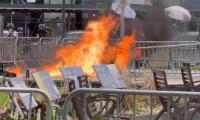LAHORE
After successful conservation and rehabilitation of Delhi Gate, Walled City of Lahore Authority (WCLA) has planned to renovate Lohari Gate, considered to be one of the earliest gates of the old Lahore city.
Recently, the authority got the gate vacated from a 40 years old illegal occupation of two families, including Fazal and Rana Sajjad, who were living inside the gate. Officials said all the gates of old Lahore, excluding Roshnai Gate, were transferred to the WCLA in 2014 and majority of them were under illegal occupation and encroachment.
Riffat Pasha, Deputy Director Building Control, WCLA said the department carried out an operation against illegal occupants on Thursday night. “We had been negotiating with these illegal occupants for the past several months,” he said, adding the families were not ready to vacate the historical monument and putting illegal demands.
Tanya Qureshi, senior WCLA official said the authority will be setting up the building control cell inside the rooms of this gate to carry out similar operations. She said all gates of Lahore would be vacated from illegal occupation but in a phased manner. Notices have been issued to all illegal occupants residing in other gates of Lahore, she maintained.
Giving historical details of Lohari Gate, she said this gate was named after the city Lahore but according to some schools of thought, numerous “Lohars” (blacksmiths) had their shops just outside the gate, for which the gate became popular as Lohari gate.
“Some historians and writers are of the view that early in the 11th century, the city was badly affected by the wars between Mahmud of Ghazna and Raja Jai Pal. At one time, it was even unpopulated. When Malik Ayaz was appointed viceroy of North India, he made Lahore, the seat of government. It was at that time, when the people started inhabiting this part and since then the gate was recognised as Lahori Gate,” she maintained.
Tanya said there was also a controversy on the name of the gate as many called it “Lahori” and many termed it as “Lohari”. She said the marble slab placed on the gate is strange too as it bears both the names besides showing the details of reconstruction of the gate in Hindi and English languages.
Lohari or Lahori Gate was initially built during the period of Mughal Emperor Akbar but some historians said the gate existed in Malik Ayaz’s times as well. During the Sikh riots the gate got smashed and was rebuilt in British period with small bricks on the same old style.
A senior archeological expert of the WCLA said the claim could be verified by excavating the foundations. He said as per history, Mughal Emperor Akbar was the one who had built a fortified wall around the city with 13 gates, and Lohari was one of the gates. The gate still has wooden arches. The rooftop is spacious with a podium in the centre. WCLA’s experts said that before the Sikh era, the red light area of the city was located inside the Lohari Gate and most of the rich dancers had built beautiful Havelis there. Chowk Matti was also named after a known dancer “Matti Bai” however with the passage of time, the red light area was shifted to Chowk Jhanda, then Tibbi Gali and eventually the present area was established. The experts added that at some places we still find beautiful Havelis which were originally the dancing houses owned by different dancers. One famous Haveli which is now under the use of cobblers is the Noori Haveli. It was also a dancing house of “Noori Bai”.
Near the entrance of this gate, is Muslim Masjid named after a Muslim scholar Maulana Muhammad Bakhsh Muslim while city’s biggest gem stone market is also situated near the gate from where one can find a variety of stones or gems. The biggest optical market of Lahore is also located inside this gate.
The gate is also famous for its traditional Lahori food spots. In old times, the gate itself had a food street due to frequent visitors.
Director General WCLA Kamran Lashari said the authority was aimed to restore and conserve the gates of Lahore and Lohari Gate is one of the most important gates. “We will set a re-use plan of the gates of Lahore so that these turn into tourist sites,” he said and concluded that the authority had already removed encroachments from Delhi Gate and now it is being used as tourism and souvenir centre.







